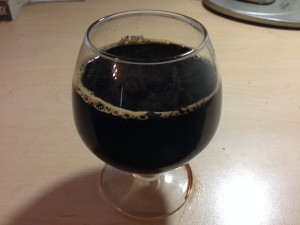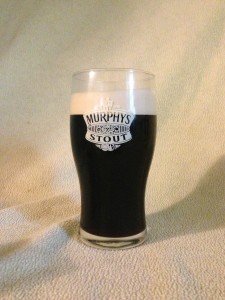 Last month, I posted the all-grain recipe for my “other” dry stout. When I make dry stout, I usually brew my Murphy’s clone. However, occasionally I’ll brew this one, which is closer to Guinness (although not an attempt to be a clone). This is a partial mash formulation of that recipe. As partial mash recipes go, the grain to malt extract ratio is high because of its low original gravity and the fact that the pale grains are mashed and the dark grains are steeped separately. The mash actually uses a starchy adjunct — flaked barley — so you can’t do a true “extract and steeped grains” version of this.
Last month, I posted the all-grain recipe for my “other” dry stout. When I make dry stout, I usually brew my Murphy’s clone. However, occasionally I’ll brew this one, which is closer to Guinness (although not an attempt to be a clone). This is a partial mash formulation of that recipe. As partial mash recipes go, the grain to malt extract ratio is high because of its low original gravity and the fact that the pale grains are mashed and the dark grains are steeped separately. The mash actually uses a starchy adjunct — flaked barley — so you can’t do a true “extract and steeped grains” version of this.
None More Black Dry Stout (Partial Mash)
None More Black Dry Stout
 I like a wide variety of beers, but one style of beer I always come back to is dry stout. Dry stout is a great session beer. It can also be a great “sobering up” beer. If you’re at the end of a long night of beer drinking, but still want one more beer, sipping a dry stout can be a great closer. It’s lower in alcohol than most beers, so you can enjoy it and also slow down a bit. It’s also a great “I could stand to lose a few pounds” beer, as the Calorie count is lower than most beers. But mostly, it’s a dark, roasty, delicious beer that is always flavorful and smells wonderful. [Read more…]
I like a wide variety of beers, but one style of beer I always come back to is dry stout. Dry stout is a great session beer. It can also be a great “sobering up” beer. If you’re at the end of a long night of beer drinking, but still want one more beer, sipping a dry stout can be a great closer. It’s lower in alcohol than most beers, so you can enjoy it and also slow down a bit. It’s also a great “I could stand to lose a few pounds” beer, as the Calorie count is lower than most beers. But mostly, it’s a dark, roasty, delicious beer that is always flavorful and smells wonderful. [Read more…]
A Second Beer From A Russian Imperial Stout
This is the seventh article in this series on Russian imperial stouts.
 Whenever you brew a big beer, there are several options for wort collection. One of them is to only collect the first wort, or the first wort and a limited amount of sparged wort. That way, you have high-gravity wort that does not need to be boiled for an extended period to hit your target OG and volume. In order to utilize this method of wort production, however, you must add more grain to your mash tun to compensate for the loss in extract efficiency.
Whenever you brew a big beer, there are several options for wort collection. One of them is to only collect the first wort, or the first wort and a limited amount of sparged wort. That way, you have high-gravity wort that does not need to be boiled for an extended period to hit your target OG and volume. In order to utilize this method of wort production, however, you must add more grain to your mash tun to compensate for the loss in extract efficiency.
Many times, there are enough sugars left over in the grain bed that you can brew a second beer. Brewing a second beer from a Russian imperial stout grist poses two types of challenges – the usual challenges associated with brewing a second beer, and those challenges specific to brewing a second beer from a partially-spent Russian imperial stout grist.
Dry Stout (Repost)
[This is a repost of our dry stout article for St. Patrick’s Day. Recipes are in the list at the bottom of this post]
[This is the first in a three-part series on dry stout. Part 2 will be posted June 20th and part 3 will be posted June 21st.]
As a homebrewer and beer drinker, I hope that the current resurgence of interest in session beers follows through to a full-fledged renaissance. My favorite session beer is Irish dry stout, exemplified on the commercial side by Guinness, Murphy’s and Beamish. Although low in alcohol and body, it is full of roasty goodness. Dry stout is a great style of beer for those who want lots of flavor, but also want to enjoy several beers before calling it a night.
Dry stout lacks the strength of a foreign export (or imperial) stout, the chewy body of an oatmeal stout and the sweetness of a sweet or milk stout. (In alcoholic beverages, “dry” means not sweet.) But dry stout is not about what is missing — it’s about the wonderful character from the darkly roasted grains, which give the beer a coffee-like flavor and aroma. Without the sweetness, body and alcohol of other stouts, the roasted grain character takes center stage. The key to brewing a great dry stout is to focus on getting the best dark grain flavor, with enough support from the other elements of the beer to round things out.
The Cure from Cork (3-Gallon/11-L All-Grain Dry Stout Recipe)
Here is an all-grain recipe for a dry stout that can be brewed on a simple 3-gallon (11-L) all-grain brewery. It is the same as the 5-gallon (19-L) all-grain recipe, just scaled to 3 gallons (11 L). (There is also a 5-gallon (19-L) partial mash version.) This same brewery setup can be used for countertop partial mashes.
This recipe is not meant to be a clone of Murphy’s Pub Draught, but it is very similar. At a low ABV (4.1%), it makes a great session beer. In addition, if you’re trying to shed a few pounds, the Calorie count for 12 oz. (355 mL) of dry stout is around 125.
For 3.0 gallons (11 L) of beer at this original gravity (9.5 °Plato, OG 1.038) , you do not need to make a yeast starter when using a tube or XL smack pack of liquid yeast. In fact, you’ll be overpitching slightly (although not to a degree that will negatively affect your beer). One key to brewing this beer well is not to oversparge. Follow the volume of wort to collect given in the recipe rather than sparging until you have your full pre-boil volume.
The Cure from Cork
(Murphy’s-like Dry Stout)
by Chris Colby
All-grain; English units
DESCRIPTION
This is a dry stout reminiscent of Murphy’s Pub Draught, now sold in widget cans. Murphy’s stout is slightly mellower — a little less bitter with a hint of chocolate and caramel in the malt — than Guinness, and (in my opinion) also tastes better when carbonated with CO2, as opposed to pushed with beer gas. If you like session ales — and are disappointed you can’t find Murphy’s except in widget cans — this is a great recipe to try.
Dry Stout (Countertop Partial Mash)
This is my dry stout recipe, formulated for a countertop partial mash. (For more on dry stouts, see the series of articles on that beer style) In this formulation, the brewer mashes 4.0 lbs. (1.8 kg) of grain in a 2-gallon (~8-L) beverage cooler. An option to mash 6.0 lbs. (2.7 kg) in a 3-gallon (~11-L) cooler is also given. In the 2-gallon (~8-L) version, 78% of the fermentables come from the mash. In fact, in both version, all of the malt extract is withheld until the end of the boil.
I have been posting a series of recipes formulated as partial mashes because I feel that partial mash homebrews have more base malt aroma than recipes in which only specialty grains are steeped. If you’re an extract beer thinking of trying all-grain brewing, this is a good recipe to try as the wort is close to being made completely from grains (especially if you try the 3-gallon (11-L) cooler option).
A 1-qt. (1-L) yeast starter is recommended for this beer, but if you get a fresh tube of yeast, you can get away without making a yeast starter.
The Cure from Cork
Dry stout
by Chris Colby
Partial mash (countertop); English units
DESCRIPTION
This is a dry stout reminiscent of Murphy’s Pub Draught, now sold in widget cans. Murphy’s stout is slightly mellower — a little less bitter with a hint of chocolate and caramel in the malt — than Guinness, and (in my opinion) also tastes better when carbonated with CO2, as opposed to pushed with beer gas. If you like session ales — and are disappointed you can’t find Murphy’s except in widget cans — this is a great recipe to try.



Recent Comments